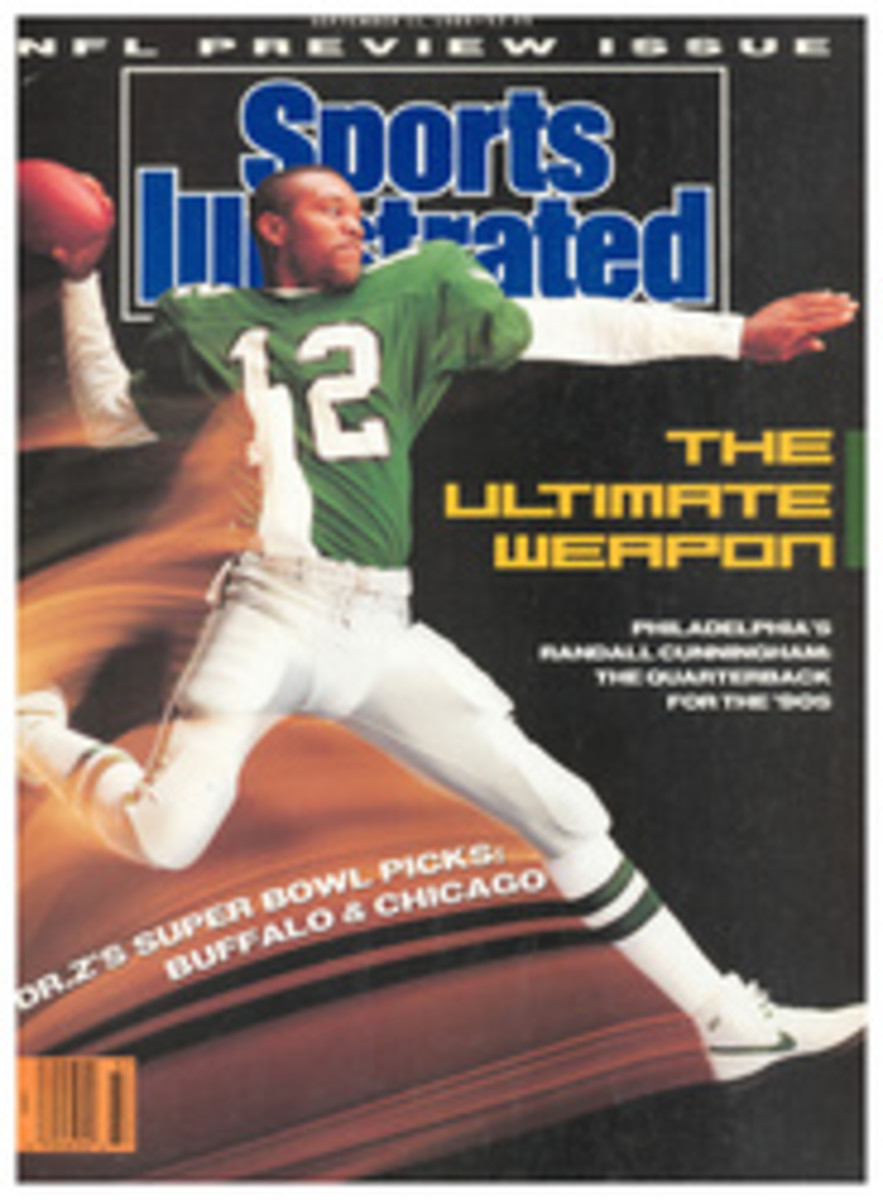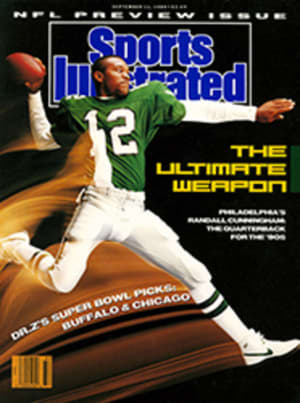
THEY'RE GETTING ON THE STICK
Unless you're a stickball player, you have no idea how serious these people are about their game. For example, Kevin Barnes kept a detailed record, including the pitchers and sites, of each of his 758 home runs. A few years ago, Barnes, 34, who has been playing stickball since his boyhood days in Fort Lee, N.J., gave out baseball jerseys in commemoration of his 500th dinger.
"I was putting down the names of every pitcher I'd ever hit a home run against and contacting all of them just to be sure, because the first couple of years I only kept track of the number but not the pitcher or site," says Barnes, a freelance sports broadcaster in Atlanta. "There was one guy I couldn't get hold of. I was pretty sure I'd hit a home run, maybe two, against him, but I hadn't talked to this guy in a long time. I finally reached his sister, and she asked him. The answer was, 'He remembers giving up two home runs against you, but he knows you never beat him in a game.' This is 17 years later!"
Or how about Perry Vitucci, 25, of the Seaford (N.Y.) Vikings, who is approaching his 1,000th homer. "We started out when we were kids putting all our friends' names on three-by-five index cards," he says, "and we kept track of our home runs. It's been almost 20 years, and now we're up to the largest-size index card." According to Vitucci, the all-time home-run record belongs to Bob Robinson, also of Seaford, who retired three years ago at age 23 with 1,146 career round-trippers.
Because of the intraneighborhood orientation of most stickball competition, however, fanatics like Barnes and Vitucci had no way to rate their accomplishments outside of their own circle. Then Ron Babineau, a telephone-systems salesman and stickball junkie from East Rockaway, N.Y., created a system to bring together the greats and near greats of the game.
"Everybody has fond memories of stickball," says the 36-year-old Babineau, who plays for the Hewlett (N.Y.) Henchmen, "but there had never been anything organized for the sport."
This is not quite true. As a high school student in Hewlett, Babineau had once organized a six-team circuit. "It was pretty loose," he recalls, "and after a few games, guys weren't showing up."
In May 1984, Babineau decided to give it a serious shot. He quit his job, wrote a rule book, devised a scoring system, declared himself commissioner and put some ads in local papers, and on June 14 the United States Stick-Ball League (USSBL) began its inaugural season with 23 teams. By the end of the campaign in August, there were 39 clubs, prompting Babineau to create a second season in the fall, at the end of which the two seasonal winners met in a one-game championship.
Since '84 the USSBL has expanded steadily. This year 142 teams of four to six players each paid the $210 entry fee for the 14-week summer season. There are teams from New York, New Jersey and Connecticut, and, thanks to Barnes, there is also a four-team division in Atlanta. The USSBL—its rosters peppered with many former college varsity baseball players and a few ex-minor leaguers—has brought a new degree of respectability to stickball and a new level of intensity to the competition. The New York Daily News publishes a list of the top 25 teams weekly.
The stickball played in the USSBL is a standardized version of the game known as "pitching in" (as opposed to the self-hitting game, or another, old-fashioned version in which the ball was delivered on one bounce by the pitcher). The dimensions of the strike zone—a rectangle chalked onto a wall—are set at 24 inches wide and 32 inches high, with the bottom line 17 inches from the ground. Base hits are determined by the distance the ball travels, and the imaginary runners are forced along according to the number of bases the batter reaches. Both teams must have the same number of fielders—three, four or five, according to the managers' pregame agreement—but each team can bat as many players as it chooses, up to the maximum roster limit of six. Individual and team statistics are meticulously—one might say compulsively—kept.
If, as it has so often been pointed out, the heart of baseball is the duel between pitcher and batter, then stickball is a cardiac-intensive distillation of baseball. "It's the closest thing there is to hardball in terms of the one-on-one challenge of batter and pitcher," says USSBL charter member Gene Sidor, 46, manager/DH of the Nitecap Bombers of Suffolk County, N.Y., and a former All-America catcher at Nassau Community College. "I love that tough competition. And it requires no running, which is fantastic at my age."
The short pitching distance (the "rubber" is 55'6" from the wall, so the batter is only about 52 feet from the pitcher), the thin bat (no more than 1‚Äö√Ñ√∂‚àö√±‚àö¬µ inches in diameter) and the tennis ball (sorry, guys, nobody plays with a "spaldeen" anymore—they haven't been made since 1979) all give the pitcher the upper hand.
"When I first joined the league I thought, 'How good can it be?' " says California Angels scout Brian Collins, 46, who played in the St. Louis Cardinals organization in the 1960s. "But I was surprised; it's very competitive. Most teams have excellent pitching. I'd say good pitchers can bring it in the mid-80's, and most of them have pretty good breaking stuff—drop balls, curves, sliders. There are a lot of strikeouts. If you hit .300 in this league, you're considered a very good hitter."
Working to the further advantage of pitchers is Equipment Rule C, which allows a pitcher to doctor the ball by burning off the fuzz, making for greater velocity and sharper breaking balls. At present, any low-felt, yellow-green tennis ball with uniform fuzz can be used in the USSBL. In an effort to standardize the sport, however, Babineau has spent more than a year overseeing the development of the quintessential stickball—i.e., one with the least possible amount of felt. "From a manufacturing standpoint, our difficulty is coming up with a totally worn-out product," says Steve Banks, president of Steegro of Gloucester, Mass., the U.S. distributor of Nassau Tennis Balls. "It hasn't been easy. We're on our third prototype now; it's getting better each time. We're hoping to have something available by the fall stickball season." Banks estimates a first run of about 24,000, with a retail cost of about $2.50 for three balls.
Through last year, only wooden sticks were allowed as bats, but this season the USSBL has recognized three official bats: the StreetStick, an ash model that retails for $10 to $12; the Quick Swing, which features an aluminum barrel, ash handle and ash top knob for $14 to $16; and the Powerflite, an all-aluminum job for $18 to $20.
Stickball traditionalists shudder at these developments. "Aluminum is fine if you want to side your house, but I certainly don't want to swing it in a stickball game," scoffs Frank Passero, 56, who has swung the same broomstick for the past 20 years, most recently for the Long Island Veterans. "But there is one thing about aluminum—you'll never have an argument on a ticked ball, because there's a ringing in your ears. If I used that bat I would need earplugs. Look, this is really a simple game. The guy throws the ball, you swing the bat and hit, and see how far it goes. Today the players have everything custom-made for them; they're trying to turn a simple game into something exotic."
Indeed, there are those who feel that the institutionalization of stickball goes against the grain of the game. "We stand directly opposed to the league," says Steven Beer, 29, one of a group of New York City professionals—most of them lawyers like Beer—who get together every Saturday morning. "Our attitude is that stickball is a game that was born in the streets and should remain there for kids of all ages to play and negotiate each time they walk out onto the asphalt. Deciding the boundaries, choosing sides, how many outs per inning—all these informal aspects are fundamental to the enjoyment of stickball for us. For some, I suppose the rules and regulations of a stickball league may be O.K., but for me and my colleagues, we would never conform to such a formal and restrictive approach to what is essentially a very simple game."
Babineau shrugs off such criticism, pointing out that membership in the league brings with it a larger focus. "Players would never know, had they not joined the USSBL, of the existence of all the other teams," he says. "They'd be playing forever in their own school yards against the same competition."
Peter Burke, 25, considered one of the league's premier pitchers (a couple of years ago he struck out 53 batters while going the distance in a 21-inning playoff game), agrees. Says Burke, whose Seaford Vikings won the overall championship last season, "Everybody out there is appreciative of the opportunity to play in an organized league."
A new USSBL division is being formed in Boston, and Babineau is exploring additional expansion plans; he sees Philadelphia, St. Louis and Baltimore, all of which have stickball traditions, as potential USSBL cities, and he welcomes inquiries from other areas. For more information about the USSBL, write Ron Babineau, P.O. Box 363, East Rockaway, N.Y. 11518, or call 516-599-2915.
PHOTO
JOHN IACONO
Jim Marciano led the Henchmen with a whopping .419 average.
PHOTO
JOHN IACONO
Commissioner Babineau, who wrote the rule book, marks out an official strike zone.
PHOTO
JOHN IACONO
This season the league sanctioned wood, wood-aluminum and all-aluminum bats.
Jay Feldman, a free-lance writer, played a lot of stickball while growing up in Brooklyn.

